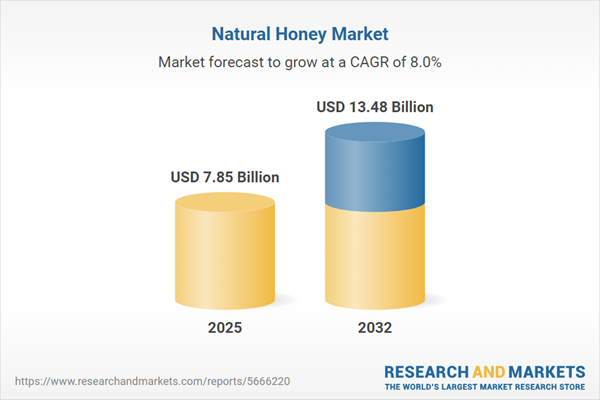Speak directly to the analyst to clarify any post sales queries you may have.
The natural honey market is undergoing marked transformation, with evolving consumer preferences, stricter regulatory standards, and the integration of traceability and innovation driving major shifts for all stakeholders.
Market Snapshot: Natural Honey Market Growth and Trends
The global natural honey market grew from USD 7.30 billion in 2024 to USD 7.85 billion in 2025, and is projected to continue expanding at a CAGR of 7.96%, reaching USD 13.48 billion by 2032. Robust demand stems from heightened health consciousness, consumer emphasis on authenticity, and the drive for sustainable sourcing across the entire supply chain. These dynamics are amplified by global climate changes affecting supply and by innovative beekeeping technologies improving production stability.
Scope & Segmentation
This comprehensive research report delivers targeted insights across key segments and geographies, supporting strategic decision making for executives and market entrants alike. Detailed coverage includes:
- Honey Types: Monofloral, polyfloral varieties capturing specialized flavor profiles and value-oriented preferences.
- Product Differentiation: Acacia, creamed, flavored (cinnamon, herbal, vanilla), honeydew, and Manuka honeys, each suited for unique end-user demands.
- Packaging Options: Bottles, jars, sachets (multi-pack, single serve), and tubes for retail, convenience, or on-the-go applications.
- End-Use Applications: Cosmetics and personal care (hair and skin care), food and beverages (baked goods, hot and cold drinks, dairy), nutraceuticals, and pharmaceuticals leveraging honey's nutritional and functional properties.
- Distribution Channels: Convenience stores, online retailers, specialty outlets, supermarkets, and hypermarkets, reflecting diverse purchasing behaviors.
- Covered Regions: Americas (United States, Canada, Mexico, Brazil, Argentina, Chile, Colombia, Peru), Europe, Middle East & Africa (including UK, Germany, France, Russia, Italy, Spain, Netherlands, Sweden, Poland, Switzerland, UAE, Saudi Arabia, Qatar, Turkey, Israel, South Africa, Nigeria, Egypt, Kenya), and Asia-Pacific (China, India, Japan, Australia, South Korea, Indonesia, Thailand, Malaysia, Singapore, Taiwan).
- Key Companies: Industry leaders such as Amish Honey, Bee Maid Honey Limited, Capilano Honey Ltd., Comvita Limited, Conagra Brands, Crockett Honey Co., Dabur India Ltd., GloryBee, Kejriwal Honey, Rowse Honey, and more.
Key Takeaways for Senior Decision-Makers
- Consumer demand for product traceability is compelling producers to implement digital tracking and transparency measures, which supports premium positioning and trust-building.
- Regulatory adjustments are elevating the need for rigorous quality standards and certification, making compliance critical for market access and brand reputation management.
- Innovative product formulations, including botanical infusions and functional enhancements, are extending honey’s role beyond a commodity, enabling companies to reach wellness-driven demographics.
- Packaging advancements and multi-format offerings cater to diverse consumer usage occasions, from traditional kitchen staples to portable solutions for active lifestyles.
- Strategic collaborations—such as partnerships with beekeeping cooperatives and nutraceutical firms—unlock supply consistency and new cross-sector distribution channels.
- Dynamic shifts in supply chains and distribution strategies are influencing retail placement, margin structures, and competitive positioning, necessitating adaptive go-to-market tactics.
Tariff Impact: Navigating Regulatory Change
The 2025 United States tariffs on imported natural honey are shifting cost structures, market shares, and sourcing strategies. International suppliers are redirecting shipments to regions less impacted by tariffs, while U.S. producers temporarily benefit from reduced import competition. However, downstream market participants face price adjustments for premium honey and must blend or substitute products to maintain profitability. Policy-driven reinvestment in domestic beekeeping and ecosystem restoration is fueling long-term innovation in hive management, although cost volatility and supply realignment remain immediate challenges.
Research Methodology & Data Sources
Insights in this report are grounded in a robust research process. Primary data was sourced from interviews with industry stakeholders—including beekeepers, processors, distributors, and regulatory experts—while surveys targeted retail buyers and application specialists for demand perspectives. Secondary sources included sector publications, regulatory documents, trade associations, and proprietary competitive intelligence databases. Analytical frameworks, such as SWOT and Porter’s Five Forces, along with scenario modeling, ensure well-rounded and actionable findings.
Why This Report Matters for Decision Makers
- Enables robust, evidence-based strategic planning leveraging deep segmentation, competitive, and regional insights.
- Supports proactive risk management with clarity on evolving tariff impacts, regulatory frameworks, and supply chain realignment.
- Facilitates smarter portfolio and go-to-market decisions through analysis of consumer trends, innovation opportunities, and distribution strategies.
Conclusion
Executives seeking to drive sustainable growth in the natural honey sector must align innovation, transparency, and adaptive partnership strategies. This report provides the actionable intelligence needed to respond to constant market change and unlock new value streams.
Additional Product Information:
- Purchase of this report includes 1 year online access with quarterly updates.
- This report can be updated on request. Please contact our Customer Experience team using the Ask a Question widget on our website.
Table of Contents
3. Executive Summary
4. Market Overview
7. Cumulative Impact of Artificial Intelligence 2025
Companies Mentioned
The companies profiled in this Natural Honey market report include:- Amish Honey
- Bee Maid Honey Limited
- Billy Bee Honey Products by McCormick & Company, Inc.
- Capilano Honey Ltd.
- Comvita Limited
- Conagra Brands, Inc.
- Cox Honey Farms
- Crockett Honey Co.
- Dabur India Ltd.
- Dutch Gold Honey
- Fairfield Organics, LLC
- GloryBee
- Hilltop Honey Ltd.
- Kejriwal Honey
- Lamex Food Group Limited
- Langnese Honey
- Little Bee Of Connecticut, LLC.
- MADHAVA LTD.
- New Zealand Honey Co
- North Dallas Honey Company d/b/a Nature Nate’s
- Really Raw Honey
- Rowse Honey
- Savannah Bee Company
- Wedderspoon Organic
- Wholesome Sweeteners, Inc.
Table Information
| Report Attribute | Details |
|---|---|
| No. of Pages | 197 |
| Published | November 2025 |
| Forecast Period | 2025 - 2032 |
| Estimated Market Value ( USD | $ 7.85 Billion |
| Forecasted Market Value ( USD | $ 13.48 Billion |
| Compound Annual Growth Rate | 7.9% |
| Regions Covered | Global |
| No. of Companies Mentioned | 26 |









